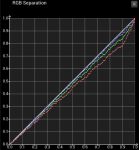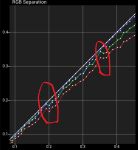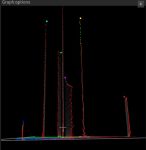Thanks for the profiles.
There are some major issues in the profiles.
(Edit: See below for the correct pre-cal profiles, as I posted the post-cal here.)The granularity of the non-linear errors is greater than the LUT size you can load into the TV.
And if it were possible to load a LUT of the required size, generating the LUT would be next to impossible due to Memory/Processing limits on just about any PC.
(Working with a large volumetric patch set with that number of points uses far, far less memory/Processing than generating a LUT)
So there is no way any calibration can correct such errors.
The Magenta is actually worse, as you can see below, as the frequency of the errors is higher.
Additionally, the TV has poor RGB Separation, so to be able to perform any sort of accurate calibration would take a volumetric profile, as is explain in the User Guides. That may actually generate a useable improvement, even with the serious errors you have.
And if you look at the RGB Separation plot you can see non-monotonic measurements, which are basically impossible unless the display/probe combination is very unstable.
And non-monotonic issues are totally un-calibratable.
So basically, that TV is un-calibratable.
Steve
Edit: What patch set did you use, and did you use Drift and Stabilisation?
The errors look like they could be heat threshold related, so actually being introduced by the profiling?
And I would like to see a CR-100 profile too, as I have previously seen such issues when they were probe issues.

Bad RGB Separation
| 
Non-monotonic
| 
Bad Magenta
|
Steve Shaw
Mob Boss at Light Illusion